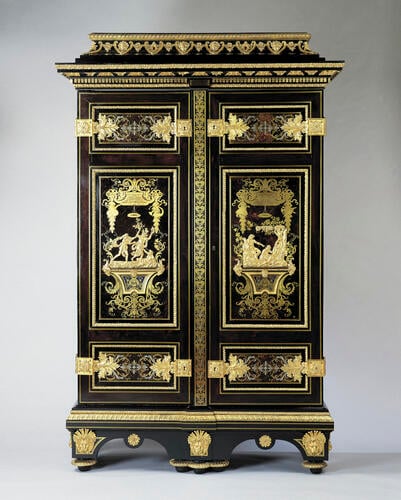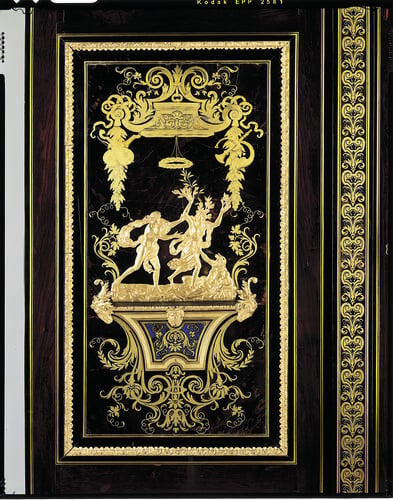-
1 of 253523 objects
Armoire c.1700
Oak, ebony, tortoiseshell, brass, pewter, kingwood, rosewood, mahogany, gilt bronze | 262.6 x 167.0 x 62.8 cm (whole object) | RCIN 21642
-
Tall rectangular armoire, inlaid with tortoiseshell and brass boulle work and with gilt metal mounts. Frieze of masks above two panelled doors each with gilt metal Classical scenes, including Apollo pursuing Daphne as she turns into a laurel tree. As furniture-maker, chaser, gilder and sculptor to Louis XIV, André-Charles Boulle enjoyed the privilege of workshops and lodgings in the Galeries du Louvre from 1672 until his death sixty years later. Monumental wardrobes (armoires) of this type were intended principally for display and are among the most magnificent and harmonious of Boulle's creations. The large flat surfaces provided a perfect vehicle for the display of Boulle's extraordinary skills as a designer and technician, allowing him to combine intricate marquetry of rich materials and finely modelled gilt bronze mounts (which he also designed and made) within a grand architectural framework. As on many of the finest pieces by Boulle, the bronzes of this piece are very carefully integrated with the marquetry. Nineteen Boulle armoires from the late seventeenth century have been identified. Features common to most of them include certain mounts and patterns of inlay. Seven armoires (including this one) are linked by the use of bronze reliefs of Apollo and Daphne and of Apollo and Marsyas on the doors. The design for these may derive from drawings of subjects from Ovid's Metamorphoses that Boulle himself once owned. Of this group of seven wardrobes, two now in the Wallace Collection share many additional features with this particular armoire. George IV had a particular fondness for Boulle furniture but it was not until he began the refurnishing of Windsor Castle in the 1820s that he acquired this and another wardrobe of similar large dimensions. Nothing is known of the provenance of this item except that it was said to have come from the Garde Meuble (the French royal furniture store). The presence of the crowned C poinçon (tax stamp) on virtually all the bronzes indicates that the armoire was in the Paris trade in the period 1745-9. After thorough restoration by Morel & Seddon in 1828, which included the insertion of a mahogany lining and new locks, the King intended to place the armoire and its companion piece in his Sitting Room at Windsor (Room 200). Perhaps on account of their overwhelming scale, they were actually installed at the angle of the Grand Corridor, where they have remained to this day. The bronzes extensively stamped with the crowned C Catalogue entry from Royal Treasures, A Golden Jubilee Celebration, London 2002
Provenance
Purchased by George IV at Phillips sale (anon.), London, 25 June 1825 (375); bought for £199 10s, and fitted with new interior by Morel and Seddon. Delivered to Morel and Seddon 1 October 1828 and later sent ot Windsor Castle.
-
Creator(s)
(furniture maker)(restorer)(nationality)Acquirer(s)
-
Medium and techniques
Oak, ebony, tortoiseshell, brass, pewter, kingwood, rosewood, mahogany, gilt bronze
Measurements
262.6 x 167.0 x 62.8 cm (whole object)
Category
Object type(s)
Other number(s)

